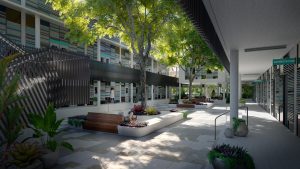
Sustainable design is the co-existence of manmade buildings and the natural world. Sustainable design has recently made its way into the field of healthcare. The nation of Kiribati, a collection of 32 islands with a total population of 110,000, is located halfway between Australia and Hawaii. The New Zealand Ministry of Foreign Affairs and Trade hired a team of health planners and architects to plan to renovate the healthcare system and facilities across Kiribati. In 2018, the designers began working on a new hospital in Betio on an island called South Tarawa in Kiribati.

The team in charge of the project utilized sustainable design when planning out and constructing the hospital. Because the islands of Kiribati are so remote, have no natural source of fresh water, and the sea level is expected to rise 5.5 inches in the next 30 years, the team implemented a few different strategies to combat these environmental issues. Firstly, to combat the rising sea level, the team significantly rose the ground plane of the building. Secondly, the team used ventilation and solar power to lessen energy consumption. They also used sustainable building materials and set up a system to harvest rainwater for flushing and irrigation. Finally, they did some landscaping work to increase the surrounding biodiversity and to help passively cool the hospital interior.
The previous design choices helped to address environmental sustainability, but the team went further to address social, economic, and some other general amenities. In a healthcare context, social sustainability is the of the institution to increase the health and overall well-being of the population. They implemented a few design initiatives to improve the general level of care for the patients. Firstly, they created a large open courtyard in the center of the hospital to make the building less institutionalized. Additionally, the team focused on the most vital hospital departments first as well as decentralizing the hospital into various small sites around the island.
In terms of economic sustainability, the designers sought to design the healthcare system in a way to combat poverty which is contributing factor to bad health outcomes in society. They utilized local workers to construct the hospital to increase the skill of local laborers and support local employment. Further, they used renewable energy throughout construction and minimized waste products which reduced the total operational cost. Finally, increased the capacity of clinical workers with improved services.
An analysis showed that, although sustainable practices are usually perceived to be more expensive, the construction of New Betio Hospital was more cost-effective than if unsustainable practices were used.
As someone who has worked in four different hospitals and under three unique healthcare systems, I was very impressed with the design of New Betio Hospital. For me, two standout features were the variety and creativity of sustainable energy consumption as well as the large open courtyard area where people could meet and talk outside of their rooms. Hopefully, New Betio Hospital can serve as an example of sustainable healthcare in action and other hospitals can adopt some of their successes.
Citations:
https://www.ache.org/blog/2021/designing-for-healthcare-sustainability-a-framework